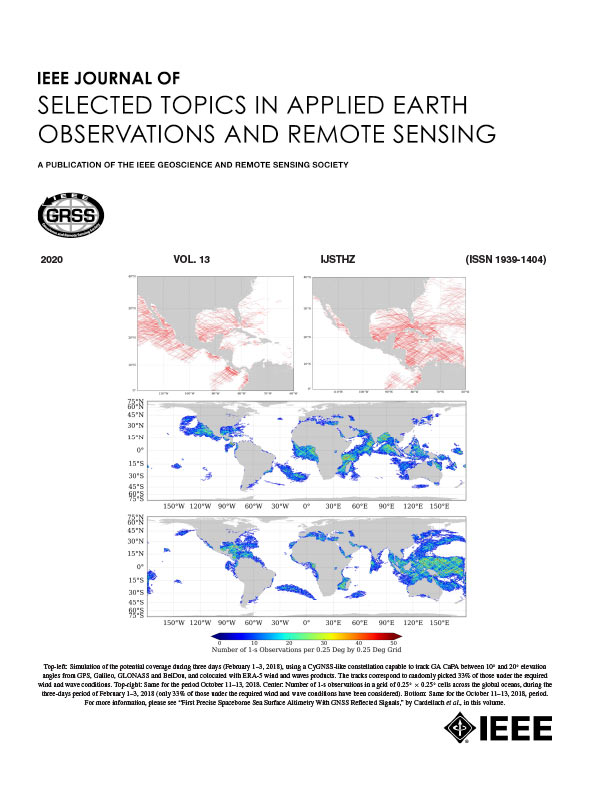Enhancing Water Bodies Detection in the Highland and Coastal Zones Through Multisensor Spectral Data Fusion and Deep Learning
IF 4.7
2区 地球科学
Q1 ENGINEERING, ELECTRICAL & ELECTRONIC
IEEE Journal of Selected Topics in Applied Earth Observations and Remote Sensing
Pub Date : 2025-06-19
DOI:10.1109/JSTARS.2025.3580595
引用次数: 0
Abstract
Accurate mapping of inland and coastal water bodies is crucial for monitoring environmental changes, managing hydrological resources, and assessing the impacts of climatic variability. This study presents a deep-learning-based semantic segmentation framework that leverages multiband Sentinel-2 imagery for delineating glaciers and coastal lakes. The dataset comprises 400 × 400-pixel image patches, constructed using false-color composites of Sentinel-2 bands 8 (NIR), 4 (red), and 3 (green), which enhance the spectral separation between water and nonwater surfaces. These bands were strategically selected to improve water body contrast and boundary definition through multisensor data fusion, enabling more precise lake border extraction. Each image patch is paired with hand-labeled binary lake masks to serve as ground truth. We developed and trained a simple U-Net in PyTorch and a shallow convolutional neural network in TensorFlow to evaluate model performance and architectural efficiency using the same dataset. Both models were assessed using standard performance metrics, including precision, recall,基于多传感器光谱数据融合和深度学习的高原海岸带水体检测
内陆和沿海水体的精确测绘对于监测环境变化、管理水文资源和评估气候变率的影响至关重要。本研究提出了一种基于深度学习的语义分割框架,该框架利用多波段Sentinel-2图像来描绘冰川和沿海湖泊。该数据集包含400 × 400像素的图像块,采用Sentinel-2波段8(近红外)、4(红色)和3(绿色)的伪色复合构建,增强了水面和非水面的光谱分离。策略性地选择这些波段,通过多传感器数据融合提高水体对比度和边界定义,实现更精确的湖泊边界提取。每个图像补丁都与手工标记的二元湖掩模配对,作为地面真实值。我们在PyTorch中开发并训练了一个简单的U-Net,在TensorFlow中开发并训练了一个浅卷积神经网络,以使用相同的数据集评估模型性能和架构效率。使用标准性能指标对两种模型进行评估,包括精度、召回率、f1评分和交叉联合(IoU)。结果表明,两种平台的分割精度都很高(F1 > 0.92, IoU > 0.86)。基于tensorflow的模型展示了更快的训练和推理,而PyTorch U-Net提供了更一致和准确的边界描绘。这项工作证明了多波段光谱融合和深度学习在遥感环境特征提取中的协同作用。提出的模型和方法具有可扩展性和适应性,可广泛应用于沿海监测、内陆水域测绘和气候相关水文评估,为不断变化的气候条件下的自动化地球观测工作流程做出了宝贵贡献。
本文章由计算机程序翻译,如有差异,请以英文原文为准。
求助全文
约1分钟内获得全文
求助全文
来源期刊
CiteScore
9.30
自引率
10.90%
发文量
563
审稿时长
4.7 months
期刊介绍:
The IEEE Journal of Selected Topics in Applied Earth Observations and Remote Sensing addresses the growing field of applications in Earth observations and remote sensing, and also provides a venue for the rapidly expanding special issues that are being sponsored by the IEEE Geosciences and Remote Sensing Society. The journal draws upon the experience of the highly successful “IEEE Transactions on Geoscience and Remote Sensing” and provide a complementary medium for the wide range of topics in applied earth observations. The ‘Applications’ areas encompasses the societal benefit areas of the Global Earth Observations Systems of Systems (GEOSS) program. Through deliberations over two years, ministers from 50 countries agreed to identify nine areas where Earth observation could positively impact the quality of life and health of their respective countries. Some of these are areas not traditionally addressed in the IEEE context. These include biodiversity, health and climate. Yet it is the skill sets of IEEE members, in areas such as observations, communications, computers, signal processing, standards and ocean engineering, that form the technical underpinnings of GEOSS. Thus, the Journal attracts a broad range of interests that serves both present members in new ways and expands the IEEE visibility into new areas.

 求助内容:
求助内容: 应助结果提醒方式:
应助结果提醒方式:


